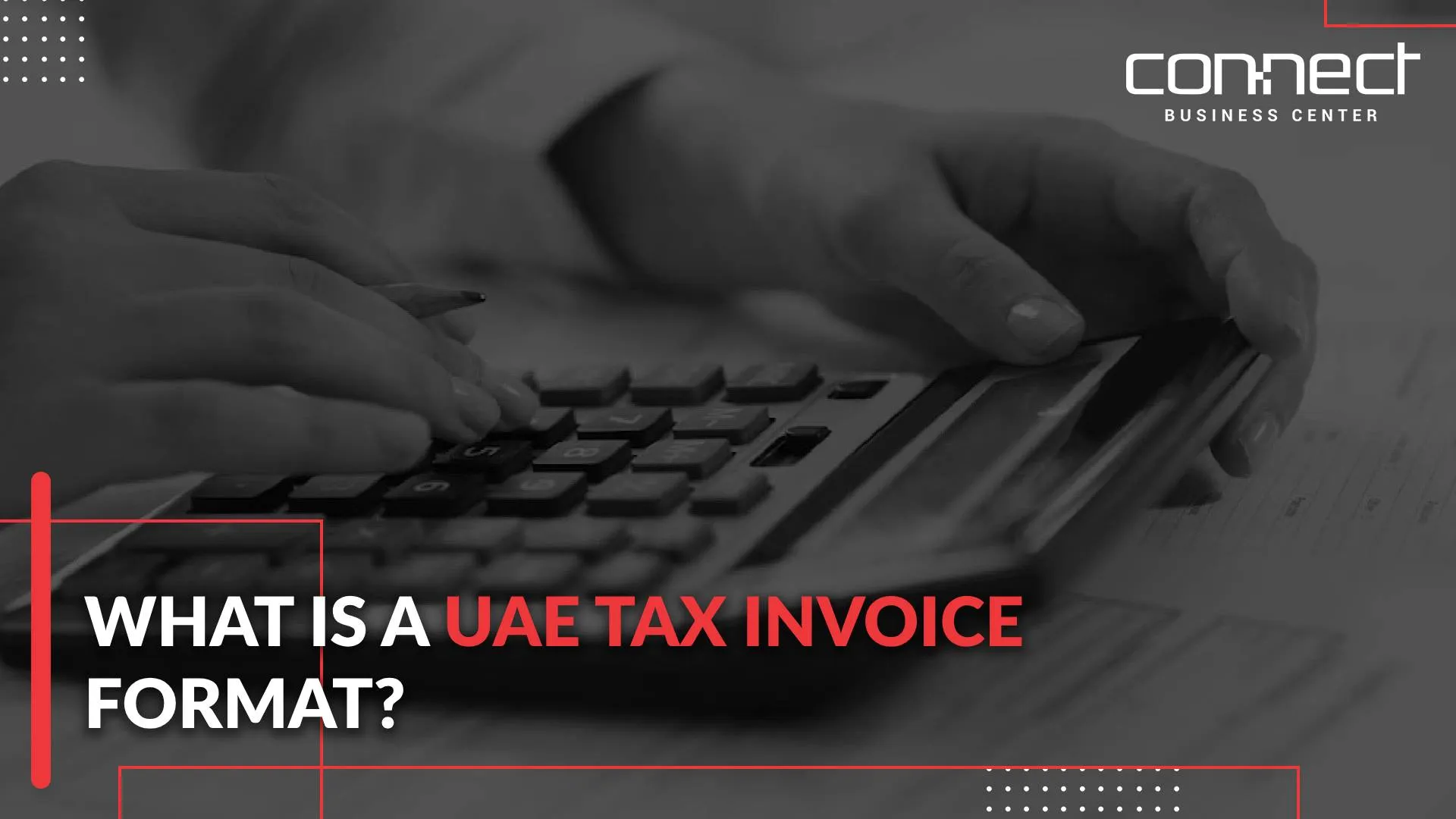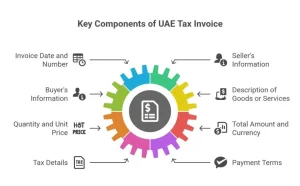In the intricate world of taxation and finance, precision and clarity are paramount. The tax invoice format UAE is a crucial aspect that businesses operating in the United Arab Emirates (UAE) must comprehend thoroughly. As a global hub for commerce, the UAE has established stringent regulations to govern tax invoices.
In this article, we will delve into the details of the UAE tax invoice format. Of course, we will describe its purpose and the essential components that make it an indispensable tool for businesses. A tax invoice format, though seemingly mundane, plays a pivotal role in the country’s taxation system. This article aims to unravel the intricacies surrounding this document, shedding light on why it is indispensable for businesses.
What is the Purpose of a UAE Tax Invoice Format?
The tax invoice format in the UAE, plays a pivotal role in the country’s taxation landscape. This structured format serves several crucial purposes, ensuring seamless financial transactions and tax compliance.
Firstly, the tax invoice format UAE is an essential tool for businesses to meet the tax invoice requirements UAE. It is a means of recording and reporting financial transactions accurately, thereby fulfilling legal obligations.
Moreover, this standardized UAE tax invoice format fosters transparency, which is a cornerstone of a robust taxation system. By providing a clear breakdown of costs, taxes, and other pertinent details, it allows for greater visibility into financial dealings.
In the UAE’s dynamic business environment, the VAT invoice format UAE also aids in input tax recovery for registered businesses. Properly maintained invoices let businesses reclaim the Value Added Tax (VAT) they paid on their purchases, reducing overall tax liability.
Furthermore, adherence to the tax invoice format is paramount for legal compliance, helping businesses avoid penalties and legal repercussions. In this respect, it acts as a shield against potential financial risks.
The Format Requirements of a UAE Tax Invoice
When it comes to the tax invoice format UAE, precision and adherence to guidelines are non-negotiable. The United Arab Emirates (UAE) has established stringent format requirements for tax invoices, crucial for businesses operating in the country.
The cornerstone of a compliant UAE tax invoice format is the proper inclusion of specific details. Firstly, the invoice must bear an unmistakable tax invoice format that distinguishes it from other financial documents.
In short, the format requirements of a tax invoice in format UAE are a meticulous framework. Such a framework is designed to ensure consistency, transparency, and legal compliance in financial transactions within the UAE. Adhering to these requirements is essential for businesses seeking to navigate the complex world of taxation in the UAE.
Key Components of a UAE Tax Invoice
The tax invoice format UAE comprises several key components that collectively ensure compliance and transparency within the UAE’s taxation system. These components are pivotal in crafting a well-structured UAE tax invoice format.
In summary, the key components of a UAE tax invoice format are meticulously designed to uphold legal standards and transparency. Indeed, they serve as a reliable tool for businesses navigating the intricate realm of UAE taxation. Adherence to these components is the linchpin of tax compliance and efficient financial transactions within the UAE.
Now, let us break down the key components of a UAE tax invoice, emphasizing their significance in maintaining compliance and transparency.
Invoice Date and Number
In the realm of the tax invoice format UAE, the invoice date and number are foundational elements. They serve as a critical identifier and chronological marker. These components are essential within the context of the UAE tax invoice format and the broader framework of the UAE’s taxation regulations.
The UAE VAT invoice format stipulates that the invoice date is the point of reference for tax authorities to determine the applicable tax period. It signifies the precise moment when the financial transaction occurred, guiding the timing of tax calculations and submissions.
Additionally, the inclusion of a unique, sequential invoice number is a non-negotiable requirement. This number, prescribed by the VAT invoice format UAE, serves multiple purposes. It helps businesses maintain an organized record of transactions and provides a distinct identifier for each invoice, preventing duplication or confusion.
Moreover, the invoice number plays a crucial role in tracking financial transactions efficiently, ensuring that businesses can accurately comply with the tax invoice requirements UAE.
Seller’s Information
Within the framework of the tax invoice format UAE, the seller’s information stands as a pivotal element, playing a fundamental role in the adherence to the UAE tax invoice format. This component, as outlined by the VAT invoice format UAE, encompasses crucial details that provide clarity and transparency in financial transactions.
Firstly, the seller’s full legal name, a non-negotiable requirement of the tax invoice format, ensures unequivocal identification. Abbreviations or informal names are not permissible, reinforcing the need for precision.
Furthermore, the inclusion of the Tax Registration Number (TRN) is paramount. As mandated by the UAE VAT invoice format, the TRN serves as a unique identifier for tax purposes. It allows for seamless verification of the seller’s legitimacy and tax compliance, providing both parties with confidence in the transaction’s integrity.
Comprehensively providing this seller’s information is not just about compliance; it is a cornerstone of trust in business transactions. It ensures that the tax invoice requirements UAE are met, protecting businesses from potential legal repercussions while establishing transparent and credible financial dealings.
Buyer’s Information
In the realm of the tax invoice format UAE, the buyer’s information holds a pivotal role, embodying the essence of transparency and legal compliance as mandated by the UAE tax invoice format. This component, an essential facet of the tax invoice format, brings the buyer into focus, ensuring that financial transactions are well-documented and adhere to the tax invoice requirements UAE.
The inclusion of the buyer’s legal name is a fundamental requirement. As outlined by the UAE VAT invoice format, this information is crucial for accurate record-keeping and establishing the identity of the purchasing entity.
Moreover, if the buyer is also a registered business, their Tax Registration Number (TRN) should be provided, aligning with the tax invoice format UAE. This addition ensures that registered buyers can effectively claim input tax recovery, a vital consideration in many transactions.
Comprehensive buyer’s information within the UAE tax invoice format is more than mere compliance; it underpins transparency and trust in the business transaction.
Description of Goods or Services
The description of goods or services is a pivotal element within the VAT invoice format UAE. This component serves as the core of any invoice, providing clarity and specificity as required by the tax invoice requirements UAE.
A comprehensive description is essential. This detail, stipulated by the UAE VAT invoice format, ensures that the nature of the goods or services is clearly understood by both parties, minimizing the risk of misinterpretation.
Furthermore, the inclusion of quantities and unit prices, as directed by the tax invoice format, bolsters the transparency of the invoice. It aids in calculating the total value of the transaction accurately.
In practice, the description of goods or services becomes the narrative of the transaction, guiding the parties involved and facilitating a seamless understanding of the financial dealings.
Overall, within the UAE tax invoice format, this component goes beyond a mere formality; it is the linchpin of precision and transparency in financial transactions, ensuring that businesses meet the tax invoice requirements UAE while maintaining credibility and trust in their dealings.
Quantity and Unit Price
The quantity and unit price aspect is a critical component within the tax invoice format UAE, pivotal in both the UAE tax invoice format and the VAT invoice format UAE. This component is central to achieving precision and transparency, aligning with the tax invoice requirements UAE.
To start, the inclusion of quantities and unit prices, as stipulated by the UAE VAT invoice format, is fundamental. These details ensure that the total value of the transaction is calculated accurately, leaving no room for ambiguity.
Moreover, specifying quantities and unit prices in the tax invoice format serves as a crucial reference point for both parties involved in the transaction. It provides clarity and enables swift verification of the financial aspects of the deal.
In essence, quantity and unit price are not just figures on a document within the UAE tax invoice format; they are the building blocks of financial precision, guaranteeing transparency and reliability in financial transactions. Adhering to these guidelines ensures businesses meet the tax invoice requirements UAE while maintaining trust and accountability in their dealings.
Total Amount and Currency
The total amount and currency segment is a critical aspect of the tax invoice requirements UAE. This component transcends mere numbers; it embodies the financial essence of the transaction.
First and foremost, the total amount payable is a culmination of all costs, taxes, and additional charges, as required by the UAE VAT invoice format. It is the bottom line, the sum that crystallizes the transaction’s value.
Furthermore, specifying the currency in which the transaction is conducted, as mandated by the tax invoice format, eliminates any potential ambiguity and ensures clarity in international or multi-currency transactions.
In practical terms, the total amount and currency component within the UAE tax invoice format is the financial compass guiding the parties involved. It is the unambiguous declaration of the transaction’s value and currency, a testament to transparency and accuracy.
In summary, the total amount and currency within the tax invoice format UAE go beyond numbers; they are the embodiment of precision and financial transparency, ensuring that businesses meet the tax invoice requirements UAE while fostering trust and accountability in financial transactions.
Tax Details (VAT, Excise Tax, etc.)
The section on tax details is a pivotal component within the VAT invoice format UAE. This segment holds the key to understanding the tax obligations associated with a transaction.
Firstly, the UAE VAT invoice format requires a transparent breakdown of any applicable taxes, particularly Value Added Tax (VAT) and excise tax. This breakdown serves as a clear roadmap, ensuring that both parties understand their respective tax liabilities.
By delineating the tax amounts as a percentage and as an actual figure, as stipulated by the tax invoice format, businesses can facilitate precise tax calculations and payments.
Moreover, for VAT-registered businesses, this breakdown is not just a matter of compliance; it also streamlines the input tax recovery process. It allows them to accurately identify and reclaim the VAT they have paid on their purchases.
In essence, tax details within the UAE tax invoice format go beyond numbers; they are the key to tax compliance, accountability, and financial precision. By adhering to these guidelines, businesses not only meet the tax invoice requirements UAE but also demonstrate their commitment to transparent and credible financial transactions within the UAE.
Payment Terms
Within the context of the tax invoice format UAE, payment terms are a pivotal element. This component delineates the timeline for financial transactions, ensuring clarity and adherence to agreed-upon terms.
To commence, specifying the payment due date is paramount. As outlined by the UAE vat invoice format, this date serves as a clear indicator of when the payment is expected, leaving no room for confusion.
Furthermore, including these payment terms within the tax invoice format aligns both parties’ expectations and responsibilities, fostering a seamless and cooperative business environment.
In practice, payment terms become a critical reference point for businesses. It ensures that the financial aspects of the transaction are executed according to the agreed-upon schedule, supporting financial planning and management.
Conclusion
In conclusion, the UAE tax invoice format is a precise and indispensable tool for businesses. Adhering to its requirements ensures legal compliance and transparency in financial transactions. Each component, from invoice date to payment terms, plays a pivotal role in fostering trust and accuracy.
This structured format aligns with the UAE’s tax regulations, particularly VAT and excise tax. It enables businesses to meet their tax obligations while facilitating input tax recovery for registered entities.
Moreover, the tax invoice format goes beyond compliance; it is a testament to financial precision and accountability. It serves as a cornerstone of trust between businesses, reassuring both buyers and sellers of the transaction’s legitimacy and transparency.
Overall, understanding and implementing the UAE tax invoice format is essential for businesses operating in this dynamic and competitive market. It ensures not only legal compliance but also the establishment of transparent and credible financial dealings, promoting trust and reliability in the UAE’s business landscape.
Would you like to know more about the tax invoice format UAE? Visit our insights section for more articles like these. If you have any questions, feel free to contact Connect Business Center.
FAQs for Tax Invoice Format UAE
What details must be included in a UAE tax invoice?
A UAE tax invoice must include the supplier’s name, address, and TRN (Tax Registration Number), the customer’s name and TRN if registered, invoice number and date, description of goods or services, quantity, unit price, total amount, VAT rate, and VAT amount.
What is the difference between a tax invoice and a simplified tax invoice?
A standard tax invoice is required for transactions above AED 10,000 and includes full details of the sale. A simplified tax invoice can be issued for transactions under AED 10,000 and only needs to show the supplier’s details, invoice number, date, total amount, and VAT amount.
How can I generate a VAT-compliant tax invoice in the UAE?
You can generate VAT-compliant invoices using accounting or invoicing software that supports UAE VAT rules, or manually by including all required information in a clear format. Ensure each invoice has a unique number and is accurate.
Are electronic tax invoices allowed in the UAE?
Yes. Electronic invoices are allowed as long as they contain all required details, are readable, and can be stored for audit purposes.
What happens if a business issues a non-compliant tax invoice?
Issuing a non-compliant invoice can lead to penalties, fines, or denial of input VAT recovery during audits by the Federal Tax Authority.
How long should tax invoices be retained for VAT purposes?
Tax invoices must be kept for at least 5 years from the end of the tax period to which they relate, in case of audits or review by the Federal Tax Authority.







